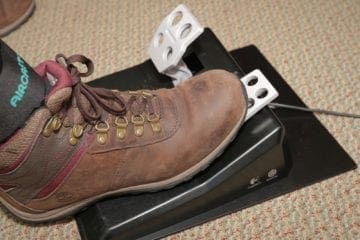Question: How can I improve my client’s reaction time?
I was recently asked by an OT colleague, what can I do to improve my client’s reaction time?
What is reaction time & how is it measured?
Lots of things come into play when it comes to a client’s ‘reaction time.’ If we think about reaction time, in terms of driving, we are probably looking at how quickly client can move from the gas to the brake pedal.
A popular measure for brake reaction is a simple reaction timer. During this test, the client presses the gas pedal, when the light changes from green to red, the client then moves as fast as possible from the gas to the brake. While this is NOT a prefect test, it gives us some general information about the client’s reaction time and helps to prepare the driver rehab specialist before proceeding to the in-vehicle assessment.
Are brake reaction testers used as a standard?
Interestingly enough, when I started in driving rehab, oh say 15+ years ago, the brake reaction timer was used as a standard for some DMVs. In fact, in Maryland, you needed to perform this test, for 10 trials, with an average of 0.50 or less to be eligible to proceed with driver test.
Over the years, evidence supporting this standard changed and this test began to disappear at DMVS.
While DMVs may no longer use this test, driver rehab specialist still find it very helpful. A fast or slow reaction can tell us a lot about what to watch for when with get in the car. It’s a great screening tool that I use to keep me & my driver safe.
So how can you impact your client’s reaction time?
Flip on your OT task analysis lens and you start to realize there are many variables that effect brake reaction from vision, to processing, notice & response, coordination, sensation, and motor movement.
A deficit in just one of these performance skills can throw off performance.
I mention the numerous performance skills because understanding your clients diagnosis and deficits will impacting potential for improvement and response to interventions. You will need to pick your intervention based on your clients need.
- Vision changes – consider further eye evaluation, contrast sensitivity, scanning activities, & visual field
- Cognitive changes – determine potential for change
- Motor & Coordination – work on eye foot activities such as kicking ball, tapping over an open faced binder
- Sensation – screen with a monofilament for intact sensation, a foot with impaired sensation should not be used for driving
Remember, if the deficit is because of a change in the brain from dementia, interventions might result in an improved motor pattern, but it won’t impact the underlying concerns. On the other hand, if the deficit is related to a muscle weakness, then we can focus interventions to improve strength, speed, & coordination.
In some situations, such as neurological conditions, medications may also impact motor performance and be something to consider as well.
To wrap it up…
- Bottom line, approach this question with evaluation & assessment, determine the performance skill deficit, and then intervene from there!
- Remember, if your client is experiencing a change in reaction time, consider recommending a hold on driving.
- Reach out your local driver rehab specialist for consultation.
- Refer your client for a full evaluation with a driver rehab specialist.
- Adaptive Mobility welcomes clients in Pennsylvania and New Jersey. In addition, we are happy to consult with any clinician and identify resources outside of our geography as well. To learn more about our services, visit https://adaptivemobility.com/services/.
